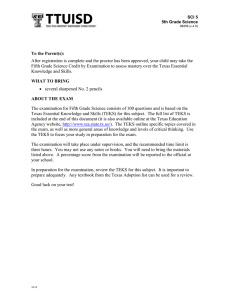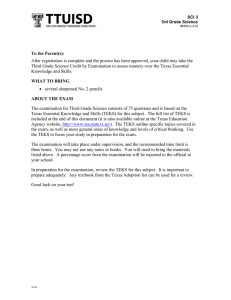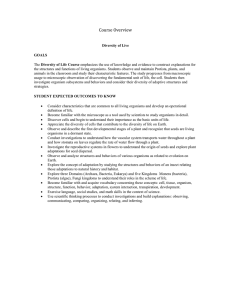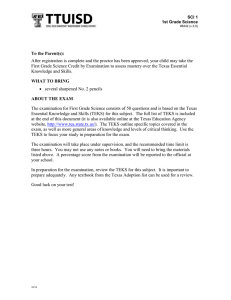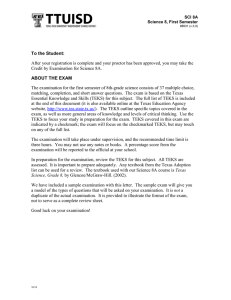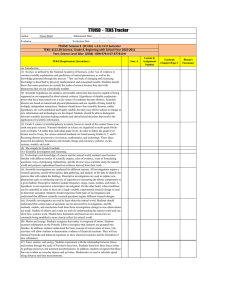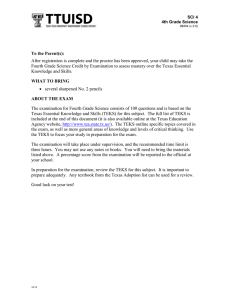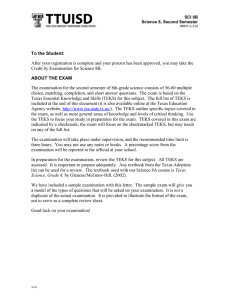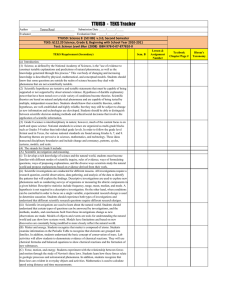After registration is complete and the proctor has been approved,... Second Grade Science Credit by Examination to assess mastery over... To the Parent(s):
advertisement
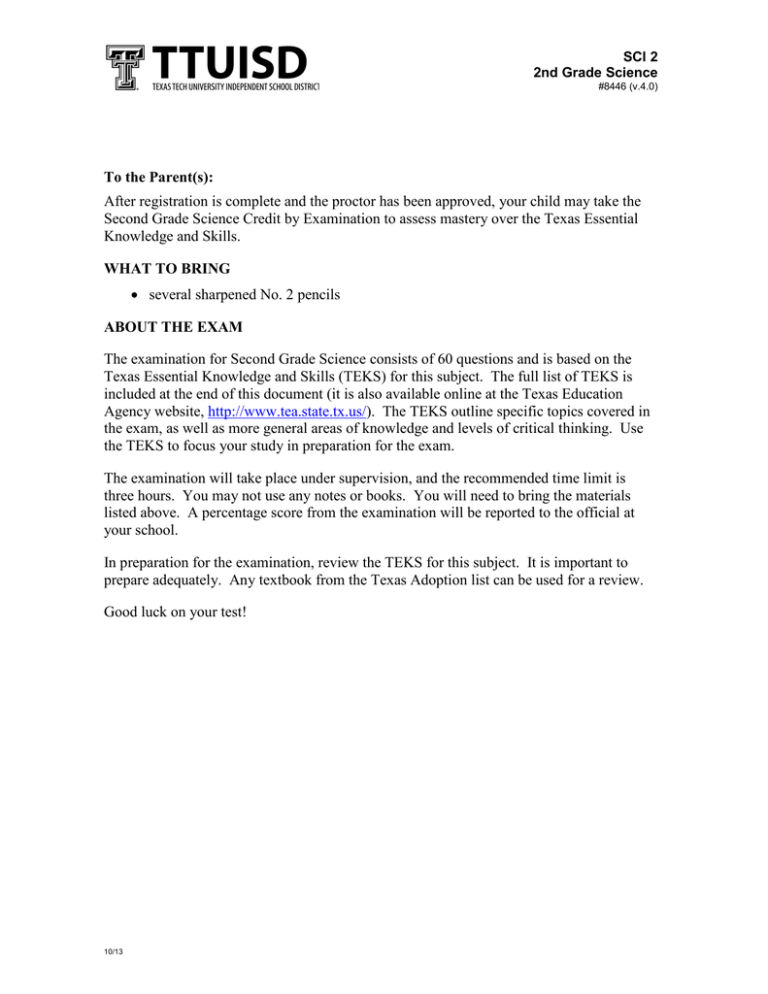
SCI 2 2nd Grade Science #8446 (v.4.0) To the Parent(s): After registration is complete and the proctor has been approved, your child may take the Second Grade Science Credit by Examination to assess mastery over the Texas Essential Knowledge and Skills. WHAT TO BRING • several sharpened No. 2 pencils ABOUT THE EXAM The examination for Second Grade Science consists of 60 questions and is based on the Texas Essential Knowledge and Skills (TEKS) for this subject. The full list of TEKS is included at the end of this document (it is also available online at the Texas Education Agency website, http://www.tea.state.tx.us/). The TEKS outline specific topics covered in the exam, as well as more general areas of knowledge and levels of critical thinking. Use the TEKS to focus your study in preparation for the exam. The examination will take place under supervision, and the recommended time limit is three hours. You may not use any notes or books. You will need to bring the materials listed above. A percentage score from the examination will be reported to the official at your school. In preparation for the examination, review the TEKS for this subject. It is important to prepare adequately. Any textbook from the Texas Adoption list can be used for a review. Good luck on your test! 10/13 Texas Essential Knowledge and Skills SCI 2 – Grade 2 Science §112.13. Science, Grade 2, Beginning with School Year 2010-2011. (a) Introduction. (1) Science, as defined by the National Academy of Sciences, is the "use of evidence to construct testable explanations and predictions of natural phenomena, as well as the knowledge generated through this process." (2) Recurring themes are pervasive in sciences, mathematics, and technology. These ideas transcend disciplinary boundaries and include patterns, cycles, systems, models, and change and constancy. (3) The study of elementary science includes planning and safely implementing classroom and outdoor investigations using scientific processes, including inquiry methods, analyzing information, making informed decisions, and using tools to collect and record information, while addressing the major concepts and vocabulary, in the context of physical, earth, and life sciences. Districts are encouraged to facilitate classroom and outdoor investigations for at least 60% of instructional time. (4) In Grade 2, careful observation and investigation are used to learn about the natural world and reveal patterns, changes, and cycles. Students should understand that certain types of questions can be answered by using observation and investigations and that the information gathered in these may change as new observations are made. As students participate in investigation, they develop the skills necessary to do science as well as develop new science concepts. (A) Within the physical environment, students expand their understanding of the properties of objects such as shape, mass, temperature, and flexibility then use those properties to compare, classify, and then combine the objects to do something that they could not do before. Students manipulate objects to demonstrate a change in motion and position. (B) Within the natural environment, students will observe the properties of earth materials as well as predictable patterns that occur on Earth and in the sky. The students understand that those patterns are used to make choices in clothing, activities, and transportation. (C) Within the living environment, students explore patterns, systems, and cycles by investigating characteristics of organisms, life cycles, and interactions among all the components within their habitat. Students examine how living organisms depend on each other and on their environment. (b) Knowledge and skills. (1) Scientific investigation and reasoning. The student conducts classroom and outdoor investigations following home and school safety procedures. The student is expected to: (A) identify and demonstrate safe practices as described in the Texas Safety Standards during classroom and outdoor investigations, including wearing safety goggles, washing hands, and using materials appropriately; (B) describe the importance of safe practices; and (C) identify and demonstrate how to use, conserve, and dispose of natural resources and materials such as conserving water and reuse or recycling of paper, plastic, and metal. (2) Scientific investigation and reasoning. The student develops abilities necessary to do scientific inquiry in classroom and outdoor investigations. The student is expected to: (A) ask questions about organisms, objects, and events during observations and investigations; (B) plan and conduct descriptive investigations such as how organisms grow; (C) collect data from observations using simple equipment such as hand lenses, primary balances, thermometers, and non-standard measurement tools; (D) record and organize data using pictures, numbers, and words; (E) communicate observations and justify explanations using student-generated data from simple descriptive investigations; and (F) compare results of investigations with what students and scientists know about the world. (3) Scientific investigation and reasoning. The student knows that information and critical thinking, scientific problem solving, and the contributions of scientists are used in making decisions. The student is expected to: (A) identify and explain a problem in his/her own words and propose a task and solution for the problem such as lack of water in a habitat; (B) make predictions based on observable patterns; and (C) identify what a scientist is and explore what different scientists do. (4) Scientific investigation and reasoning. The student uses age-appropriate tools and models to investigate the natural world. The student is expected to: 2 (A) collect, record, and compare information using tools, including computers, hand lenses, rulers, primary balances, plastic beakers, magnets, collecting nets, notebooks, and safety goggles; timing devices, including clocks and stopwatches; weather instruments such as thermometers, wind vanes, and rain gauges; and materials to support observations of habitats of organisms such as terrariums and aquariums; and (B) measure and compare organisms and objects using non-standard units that approximate metric units. (5) Matter and energy. The student knows that matter has physical properties and those properties determine how it is described, classified, changed, and used. The student is expected to: (A) classify matter by physical properties, including shape, relative mass, relative temperature, texture, flexibility, and whether material is a solid or liquid; (B) compare changes in materials caused by heating and cooling; (C) demonstrate that things can be done to materials to change their physical properties such as cutting, folding, sanding, and melting; and (D) combine materials that when put together can do things that they cannot do by themselves such as building a tower or a bridge and justify the selection of those materials based on their physical properties. (6) Force, motion, and energy. The student knows that forces cause change and energy exists in many forms. The student is expected to: (A) investigate the effects on an object by increasing or decreasing amounts of light, heat, and sound energy such as how the color of an object appears different in dimmer light or how heat melts butter; (B) observe and identify how magnets are used in everyday life; (C) trace the changes in the position of an object over time such as a cup rolling on the floor and a car rolling down a ramp; and (D) compare patterns of movement of objects such as sliding, rolling, and spinning. (7) Earth and space. The student knows that the natural world includes earth materials. The student is expected to: (A) observe and describe rocks by size, texture, and color; (B) identify and compare the properties of natural sources of freshwater and saltwater; and (C) distinguish between natural and manmade resources. (8) Earth and space. The student knows that there are recognizable patterns in the natural world and among objects in the sky. The student is expected to: (A) measure, record, and graph weather information, including temperature, wind conditions, precipitation, and cloud coverage, in order to identify patterns in the data; (B) identify the importance of weather and seasonal information to make choices in clothing, activities, and transportation; (C) explore the processes in the water cycle, including evaporation, condensation, and precipitation, as connected to weather conditions; and (D) observe, describe, and record patterns of objects in the sky, including the appearance of the Moon. (9) Organisms and environments. The student knows that living organisms have basic needs that must be met for them to survive within their environment. The student is expected to: (A) identify the basic needs of plants and animals; (B) identify factors in the environment, including temperature and precipitation, that affect growth and behavior such as migration, hibernation, and dormancy of living things; and (C) compare and give examples of the ways living organisms depend on each other and on their environments such as food chains within a garden, park, beach, lake, and wooded area. (10) Organisms and environments. The student knows that organisms resemble their parents and have structures and processes that help them survive within their environments. The student is expected to: (A) observe, record, and compare how the physical characteristics and behaviors of animals help them meet their basic needs such as fins help fish move and balance in the water; (B) observe, record, and compare how the physical characteristics of plants help them meet their basic needs such as stems carry water throughout the plant; and (C) investigate and record some of the unique stages that insects undergo during their life cycle. Source: The provisions of this §112.13 adopted to be effective August 4, 2009, 34 TexReg 5063. 3
